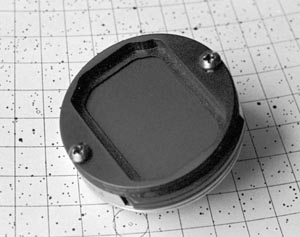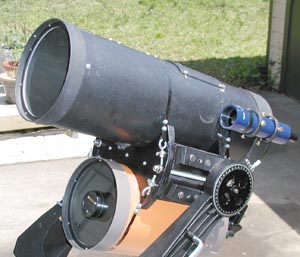
(These pages are published for anybody interested in Schmidtcameras on this page with permission by Robert Reeves)

 |
 |
| The author's 8-inch Schmidt camera mounted atop a C-11 fork assembly with an 8-inch Celestron guide scope. | The C-11 fork assembly tracks well enough to secure good photos, but to poorly allow the use of an autoguider. |

A unique feature of the Schmidt design is that while the corrector and mirror optics of the Schmidt focuses e incoming light rays perfectly, the resulting focal plane is curved. This introduces the need for the Schmidt's second innovation; the film plane is deliberately curved to match the curved focal plane of the mirror. The Celestron/Epoch-type Schmidt cameras use single exposure film holders that are installed into the camera through a door in the side of the camera body. Thirty-five millimeter film holders for the Celestron/Epoch cameras all look alike but in fact, there are two separate types. One is designed for use in "white light", that is, without a Kodak Wratten gel filter. The other type is for use with a Wratten gel filter. The two are noninterchangable because the film holder designed for use with filters is machined to compensate for the focus shift when using filters. A dowel pin indexes the film holder's orientation while a magnetic retainer holds the film holder at the proper focus point on a spider assembly similar to that of a Newtonian secondary mirror holder. The indexing pin prevents lateral movement of the film holder by no more the .002 inches. But in practical terms, the film holder is untouched during the exposure so the magnetic mount keeps the film holder stationary. The retainer allows the film holder to be installed with the 35 mm film's long dimension oriented either north-south or east-west.
 |
 |
| The white light filter holder exposes the film directly to starlight with no filter assembly attached. | The filter film holder is seemingly identical to the while light holder except it is machined to maintain focus with the Wratten filter attached in front of the holder. |
 |
 |

Go to the next page ----The Pros and Cons of a Schmidt Camera
| Astrophotography With a Schmidt Telescope Atlas of Deep Sky Splendors ATM Book 2 ATM Book 3 Practical Computer-Aided Lens Design Telescope Optics The Celestron Schmidt Camera Wide-Field Astrophotography |
Marx & Pfau Hans Vehrenberg Albert Ingals, Editor Albert Ingals, Editor Gregory Hallock Smith Rutten & van Venrooij (owner's manual) Robert Reeves |